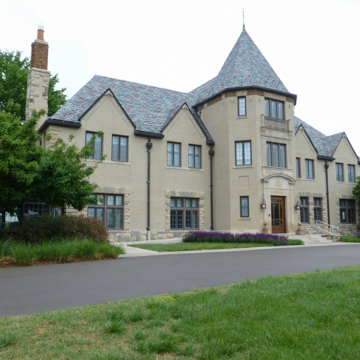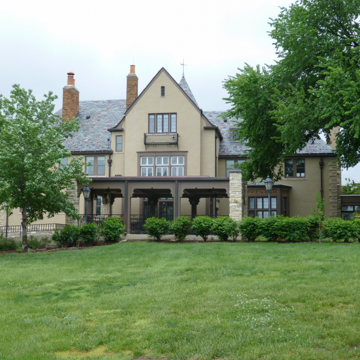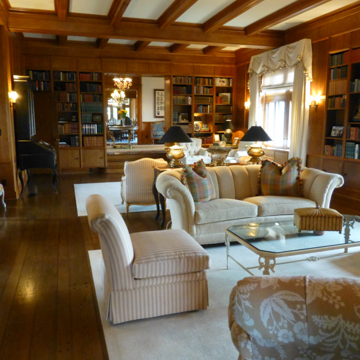You are here
Cedar Crest
Cedar Crest was built for Frank MacLennan, the longtime publisher of the Topeka State Journal. MacLennan amassed 322 acres in the rolling hills on the west side of Topeka, demolishing an existing farmstead to build his baronial mansion. The house was designed by William Drewin Wight (1882–1947), a partner in the well-respected Kansas City architectural firm Wight and Wight, best known for its Classical Revival institutional work. At MacLennan’s direction, Wight drew upon French and English country houses.
The Wight brothers were responsible for a number of significant buildings in Kansas City. Their design for the neoclassical Wyandotte County Courthouse was typical of their public buildings, but William Wight had diverse interests, and was happy to incorporate features his client had admired in the country houses he had seen in his European travels. MacLennan was very involved in the design process, and in particular the detailed carvings in his study. The resulting building gave the impression of grandeur and formality, while also incorporating unique picturesque elements into the composition. The south-facing front facade is largely symmetrical and is centered on a three-story tower. The other facades are more irregular, accommodating a complex program. Recently constructed houses in many of Kansas’s more affluent suburbs, like those in Johnson County in western suburbs of Kansas City, seem to follow many of Cedar Crest’s formal strategies albeit on a more modest scale and placed on smaller lots.
At Cedar Crest, one enters the house through the central tower and into a grand stair hall. To the left (or west) is a large living room, several steps down from the entry, and a screened porch beyond. To the right (or east) is the formal dining room with a glazed conservatory beyond. Service spaces are located on the northern side of the eastern portion of the house. The ground floor of the house, at the direction of the original owner’s will, has remained largely true to its original appearance. For example, it continues to house MacLennan’s library. The upper floors, which are not accessible to the public, have been altered to accommodate the needs of the series of governors who have lived in the house.
MacLennan was born in 1855 in Springfield, Ohio, and moved with his family to Emporia when he was fifteen years old. He attended the University of Kansas, earning undergraduate and graduate degrees in 1875 and 1877. He then returned to Emporia, where he worked for the local newspaper, the Emporia Daily News, for eight years. MacLennan jumped at the opportunity to purchase the Topeka Daily News in an auction in 1885. The paper gained a strong reputation and wide circulation based on its thoughtful stance on public issues. MacLennan became a leader among the national press, serving as the Vice President of the Associated Press in 1911 and 1912, and as a Director from 1919 until 1933.
MacLennan died in 1933, only three years after the house was completed, but his widow, Madge Overstreet MacLennan, continued to live in the house until her death in 1955. Two years later the state accepted the gift of the house and its grounds, as bequeathed in her will. By 1961 it had been restored and became the home of Governor John Anderson. It has been the residence of all Kansas governors since this time, and has proved to be an appropriate venue for many public functions. A large portion of the grounds has become a public park.
References
Small, Nora Pat, “Cedar Crest,” Shawnee County, Kansas. National Register of Historic Places Inventory–Nomination Form, 1982. National Park Service, U.S. Department of the Interior, Washington, D.C.
Writing Credits
If SAH Archipedia has been useful to you, please consider supporting it.
SAH Archipedia tells the story of the United States through its buildings, landscapes, and cities. This freely available resource empowers the public with authoritative knowledge that deepens their understanding and appreciation of the built environment. But the Society of Architectural Historians, which created SAH Archipedia with University of Virginia Press, needs your support to maintain the high-caliber research, writing, photography, cartography, editing, design, and programming that make SAH Archipedia a trusted online resource available to all who value the history of place, heritage tourism, and learning.








